Nikos Piperigkos
A holistic perception system of internal and external monitoring for ground autonomous vehicles: AutoTRUST paradigm
Aug 25, 2025Abstract:This paper introduces a holistic perception system for internal and external monitoring of autonomous vehicles, with the aim of demonstrating a novel AI-leveraged self-adaptive framework of advanced vehicle technologies and solutions that optimize perception and experience on-board. Internal monitoring system relies on a multi-camera setup designed for predicting and identifying driver and occupant behavior through facial recognition, exploiting in addition a large language model as virtual assistant. Moreover, the in-cabin monitoring system includes AI-empowered smart sensors that measure air-quality and perform thermal comfort analysis for efficient on and off-boarding. On the other hand, external monitoring system perceives the surrounding environment of vehicle, through a LiDAR-based cost-efficient semantic segmentation approach, that performs highly accurate and efficient super-resolution on low-quality raw 3D point clouds. The holistic perception framework is developed in the context of EU's Horizon Europe programm AutoTRUST, and has been integrated and deployed on a real electric vehicle provided by ALKE. Experimental validation and evaluation at the integration site of Joint Research Centre at Ispra, Italy, highlights increased performance and efficiency of the modular blocks of the proposed perception architecture.
Optimizing Cooperative Multi-Object Tracking using Graph Signal Processing
Jun 11, 2025Abstract:Multi-Object Tracking (MOT) plays a crucial role in autonomous driving systems, as it lays the foundations for advanced perception and precise path planning modules. Nonetheless, single agent based MOT lacks in sensing surroundings due to occlusions, sensors failures, etc. Hence, the integration of multiagent information is essential for comprehensive understanding of the environment. This paper proposes a novel Cooperative MOT framework for tracking objects in 3D LiDAR scene by formulating and solving a graph topology-aware optimization problem so as to fuse information coming from multiple vehicles. By exploiting a fully connected graph topology defined by the detected bounding boxes, we employ the Graph Laplacian processing optimization technique to smooth the position error of bounding boxes and effectively combine them. In that manner, we reveal and leverage inherent coherences of diverse multi-agent detections, and associate the refined bounding boxes to tracked objects at two stages, optimizing localization and tracking accuracies. An extensive evaluation study has been conducted, using the real-world V2V4Real dataset, where the proposed method significantly outperforms the baseline frameworks, including the state-of-the-art deep-learning DMSTrack and V2V4Real, in various testing sequences.
Personalized Federated Learning for Cross-view Geo-localization
Nov 07, 2024



Abstract:In this paper we propose a methodology combining Federated Learning (FL) with Cross-view Image Geo-localization (CVGL) techniques. We address the challenges of data privacy and heterogeneity in autonomous vehicle environments by proposing a personalized Federated Learning scenario that allows selective sharing of model parameters. Our method implements a coarse-to-fine approach, where clients share only the coarse feature extractors while keeping fine-grained features specific to local environments. We evaluate our approach against traditional centralized and single-client training schemes using the KITTI dataset combined with satellite imagery. Results demonstrate that our federated CVGL method achieves performance close to centralized training while maintaining data privacy. The proposed partial model sharing strategy shows comparable or slightly better performance than classical FL, offering significant reduced communication overhead without sacrificing accuracy. Our work contributes to more robust and privacy-preserving localization systems for autonomous vehicles operating in diverse environments
Real time enhancement of operator's ergonomics in physical human - robot collaboration scenarios using a multi-stereo camera system
Apr 11, 2023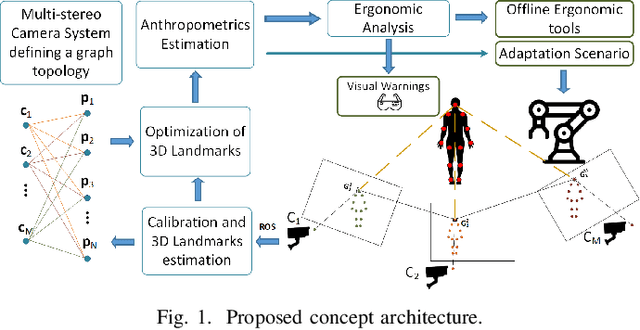
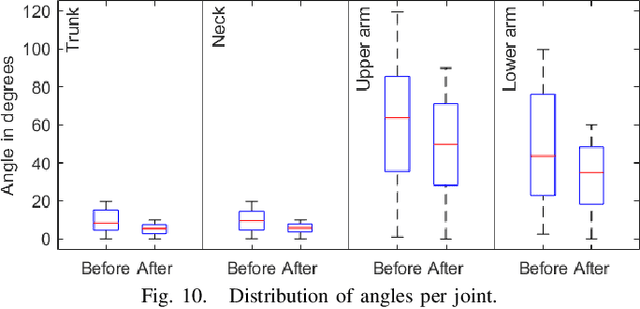

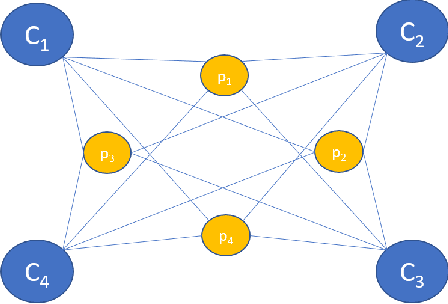
Abstract:In collaborative tasks where humans work alongside machines, the robot's movements and behaviour can have a significant impact on the operator's safety, health, and comfort. To address this issue, we present a multi-stereo camera system that continuously monitors the operator's posture while they work with the robot. This system uses a novel distributed fusion approach to assess the operator's posture in real-time and to help avoid uncomfortable or unsafe positions. The system adjusts the robot's movements and informs the operator of any incorrect or potentially harmful postures, reducing the risk of accidents, strain, and musculoskeletal disorders. The analysis is personalized, taking into account the unique anthropometric characteristics of each operator, to ensure optimal ergonomics. The results of our experiments show that the proposed approach leads to improved human body postures and offers a promising solution for enhancing the ergonomics of operators in collaborative tasks.
Graph Laplacian Diffusion Localization of Connected and Automated Vehicles
Aug 24, 2021



Abstract:In this paper, we design distributed multi-modal localization approaches for Connected and Automated vehicles. We utilize information diffusion on graphs formed by moving vehicles, based on Adapt-then-Combine strategies combined with the Least-Mean-Squares and the Conjugate Gradient algorithms. We treat the vehicular network as an undirected graph, where vehicles communicate with each other by means of Vehicle-to- Vehicle communication protocols. Connected vehicles perform cooperative fusion of different measurement modalities, including location and range measurements, in order to estimate both their positions and the positions of all other networked vehicles, by interacting only with their local neighborhood. The trajectories of vehicles were generated either by a well-known kinematic model, or by using the CARLA autonomous driving simulator. The various proposed distributed and diffusion localization schemes significantly reduce the GPS error and do not only converge to the global solution, but they even outperformed it. Extensive simulation studies highlight the benefits of the various approaches, outperforming the accuracy of the state of the art approaches. The impact of the network connections and the network latency are also investigated.
Cooperative Multi-Modal Localization in Connected and Autonomous Vehicles
Jul 16, 2021
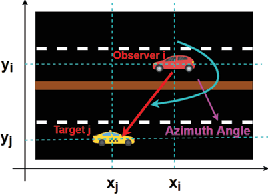
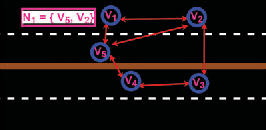

Abstract:Cooperative Localization is expected to play a crucial role in various applications in the field of Connected and Autonomous vehicles (CAVs). Future 5G wireless systems are expected to enable cost-effective Vehicle-to-Everything (V2X)systems, allowing CAVs to share with the other entities of the network the data they collect and measure. Typical measurement models usually deployed for this problem, are absolute position from Global Positioning System (GPS), relative distance and azimuth angle to neighbouring vehicles, extracted from Light Detection and Ranging (LIDAR) or Radio Detection and Ranging(RADAR) sensors. In this paper, we provide a cooperative localization approach that performs multi modal-fusion between the interconnected vehicles, by representing a fleet of connected cars as an undirected graph, encoding each vehicle position relative to its neighbouring vehicles. This method is based on:i) the Laplacian Processing, a Graph Signal Processing tool that allows to capture intrinsic geometry of the undirected graph of vehicles rather than their absolute position on global coordinate system and ii) the temporal coherence due to motion patterns of the moving vehicles.
 Add to Chrome
Add to Chrome Add to Firefox
Add to Firefox Add to Edge
Add to Edge